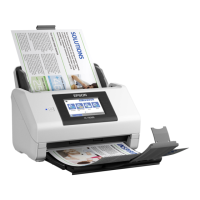Related Information
& “Carrier Sheet Codes” on page 31
Specications of Envelopes
e
specication
of envelopes you can load into the scanner.
Size Measurement Thickness Loading Capacity
C6 114×162 mm (4.49×6.38 in.)
(standard size)
0.38 mm (0.015 in.) or less 10 envelopes
DL 110×220 mm (4.33×8.66 in.)
(standard size)
Types of Originals that Require Attention
e following types of originals may not be successfully scanned.
❏ Originals with an uneven surface such as letter head paper.
❏ Originals with wrinkles or fold lines
❏ Perforated originals
❏ Original with labels or stickers
❏ Carbon-less paper
❏ Curled originals
❏ Coated paper
c
Important:
Carbon-less paper contains chemical substances that may harm the rollers. If you scan carbon-less paper, clean the
pickup roller and the separation roller regularly. Also, scanning carbon-less paper may shorten the life cycle of the
rollers faster than scanning plain paper.
Note:
❏ Crinkled originals may scan better if you slow down the feeding speed during scanning or smooth out the crinkles before
loading.
❏ To scan delicate originals or originals that are easily crinkled, use the Carrier Sheet (sold separately).
❏ To scan originals that are incorrectly detected as double feeds, set the DFDS Function (Double Feed Detection Skip
Function) to On on the control panel before you resume scanning, or select O in Detect Double Feed on the Main
Settings tab in the Epson Scan 2 window.
When you are using Document Capture Pro, you can open the window by pressing the Detailed Settings button on the
Scan Settings screen.
❏ Labels or stickers must be rmly stuck to the originals with no glue protruding.
❏ Try to atten the curled originals before scanning.
Specications and Placing of Originals
>
Specications of Originals
>
Types of Originals that Require
…
39

